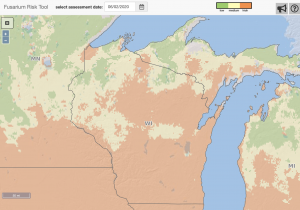Wisconsin Winter Wheat Disease Update – June 2, 2020
Damon Smith, Extension Field Crops Pathologist, Department of Plant Pathology, University of Wisconsin-Madison
Brian Mueller, Assistant Field Researcher, Department of Plant Pathology, University of Wisconsin-Madison

Figure 1. Fusarium Risk Tool prediction for FHB-susceptible varieties of winter wheat in Wisconsin on June 2, 2020.
Winter wheat in Wisconsin is moving through growth stages very rapidly over the past week due to ample moisture and heat. I have visited several fields this week with heads emerging or almost completely emerged. Anthesis (flowering) will begin in many winter wheat fields this week, if it hasn’t already started.
With the start of anthesis comes the critical time to consider a fungicide application for Fusarium head blight (FHB or scab). The Fusarium Risk Tool is showing very favorable conditions for the major wheat producing areas of Wisconsin, for susceptible varieties (Fig. 1). Risk is also medium-to-high in these zones for moderately susceptible varieties. Given the heat and high humidity with the multiple chances of rain predicted, a fungicide application may be warranted at this time in your winter wheat fields, especially if you have susceptible varieties.
Remember that the best time to apply a fungicide for FHB control is at the start of anthesis, up to 7 days after the start of anthesis. In Wisconsin, our research has demonstrated that we can significantly reduce the levels of deoxynivalenol (DON or vomitoxin) in finished grain if we wait until 5 days after the start of anthesis to apply our FHB fungicide. This is due to the fact that we often have uneven head emergence in our fields and delaying applications a few days after the start of anthesis can let these heads (or those on secondary tillers) “catch up.”
Fungicides considered most consistent in efficacy in University research include Prosaro®, Caramba®, and Miravis Ace®. Efficacy ratings for these and other products can be found on the Crop Protection Network’s Fungicide Efficacy for Control of Wheat Diseases fact sheet. Results from fungicide efficacy trials from the Badger Crop Docs, can be found BY CLICKING HERE. Research trials from 2019 that include the newest fungicide, Miravis Ace®, can be found BY CLICKING HERE and scrolling down to the last several pages. Remember, that the goal is to reduce damage by FHB and reduce DON levels as far below 2ppm as possible. The ideal method to do this includes an integrated approach of using resistant varieties and well-timed fungicide applications.
In our travels over the past week we also found stripe rust at very low levels in the Wisconsin Winter Wheat Variety trial located in Chilton, WI (Calumet Co.). We have documented this on the stripe rust monitor (Fig. 2). This was at low severity on flag leaves of known susceptible and moderately susceptible varieties of winter wheat. We have not observed stripe rust in the other variety trials in the state, or in other fields we have visited at this point. I believe that the high heat will keep stripe rust moving slowly. In addition, fungicide applications that will be applied for FHB control will also be effective in reducing the severity of stripe rust.
Now is the time to get out and SCOUT, SCOUT, SCOUT and make those educated fungicide spraying decisions!






